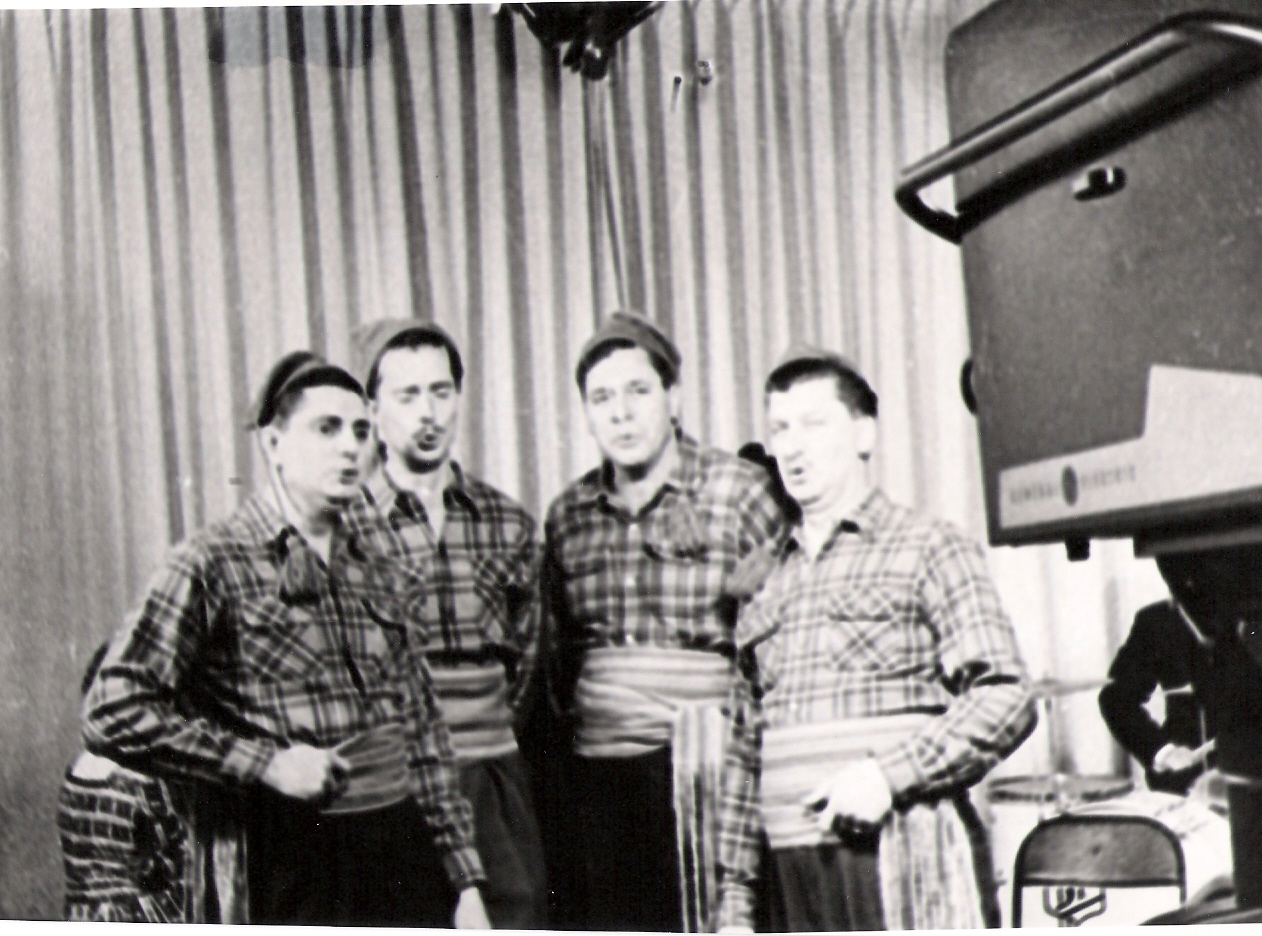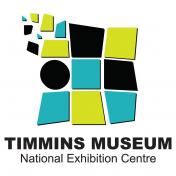Les Gais Lurons, 1960, artiste inconnu, collection Musée de Timmins : Centre d’exposition national, 982.41.3.
Courtoisie du Musée de Timmins : Centre d’exposition national.

Les Gais Lurons, 1960, unknown artist, Timmins Museum: NEC collection, 982.41.3.
Courtesy of the Timmins Museum: National Exhibition Centre.
Apprenez-en plus! / Learn more!


Le groupe Les Gais Lurons a été créé à Timmins en 1941. Un des fondateurs fut François Lucien Boivin et Conrad Lavigne chantait dans quatuor. Dix ans plus tard, Conrad Lavigne crée le poste CFCL, la première station de radio de langue française en Ontario. Les Gais Lurons chantent régulièrement sur les ondes de CFCL.
Né le 2 novembre 1916 à Chénéville (Québec), Conrad Lavigne grandit chez un oncle à Cochrane, exploite un petit commerce, puis s’engage dans l’armée en 1942. Après la guerre, il s’installe à Kirkland Lake où il achète un hôtel. En 1951, Lavigne obtient le premier permis pour opérer un poste de radio francophone hors Québec, CFCL-Timmins. Dans les années qui suivent, l’homme d’affaires met sur pied le réseau de télévision Mid-Canada, dont il sera le propriétaire de 1955 à 1980. Ce réseau s’étend à tout le Nord-Est ontarien avec des stations à Sudbury, North Bay et Elliot Lake, puis, plus tard, à Pembroke et à Ottawa.
En 1993, J. Conrad Lavigne publie son autobiographie intitulée Tours de force, où il raconte ses nombreux souvenirs d’orphelin, de jeune homme d’affaires, de soldat, de radiodiffuseur, d’entrepreneur, d’administrateur et de millionnaire. Il est décédé à Timmins le 16 avril 2003.
Le 21 septembre 2005, la Fiducie du patrimoine ontarien a dévoilé une plaque commémorant la fondation de la station de radio CFCL (Canadien Français Conrad Lavigne). Le texte se lit comme suit : « Première station de radio française en Ontario, CFCL Timmins a commencé à diffuser des émissions en décembre 1951. Cet événement a été accueilli avec enthousiasme par les Franco-Ontariens qui, à l’époque, n’entendaient que rarement des émissions en français sur les ondes. La station mettait en valeur le talent local et créait parmi ses auditeurs francophones, éparpillés dans tout le Nord de l’Ontario, de Kirkland Lake à Hearst, un sentiment d’appartenance communautaire. Grâce à ses émissions quotidiennes sur la vie en français dans la région, la station a stimulé chez les francophones une fierté culturelle et l’amour de la langue française, et les a sensibilisés à l’importance de l’éducation en français et des études supérieures. La création de CFCL par M. Conrad Lavigne, fondateur-propriétaire, a marqué un tournant dans le développement culturel des collectivités franco-ontariennes du Nord de la province. »
The Gais Lurons group was established in Timmins in 1941. The quartet was notably composed of founder François Lucien Boivin and singer Conrad Lavigne. Ten years later, Conrad Lavigne founded CFCL, Ontario’s first French language radio station, on which the Gais Lurons regularly sang.
Born on November 2, 1916 in Chénéville (Québec), Conrad Lavigne lived with an uncle in Cochrane during his childhood, operating a small business before joining the army in 1942. After the war, he moved to Kirkland Lake and bought a hotel. In 1951, Lavigne got the first license to operate a French-language radio station outside of Québec, which he named CFCL-Timmins. In the following years, he founded the Mid-Canada television network, which he owned from 1955 to 1980. The network’s coverage included all of northeastern Ontario with stations in Sudbury, North Bay, Elliot Lake, and later Pembroke and Ottawa.
In 1993, J. Conrad Lavigne published his autobiography titled Tours de force, in which he recounts his memories as an orphan, young businessman, soldier, broadcaster, entrepreneur, administrator and millionaire. He died in Timmins on April 16, 2003.
On September 21, 2005, the Ontario Heritage Trust unveiled a plaque commemorating the founding of radio station CFCL (standing for “Canadien Français Conrad Lavigne”). It read: “As the first francophone radio station in Ontario, CFCL-Timmins began broadcasting in December 1951. This event was enthusiastically welcomed by Franco-Ontarians who, at the time, only rarely heard live broadcasts in French. The station promoted local talent and created a sense of community among its francophone listeners, scattered as they were throughout northern Ontario from Kirkland Lake to Hearst. Through its daily broadcasts about life in French in the area, the station fostered a sense of cultural pride and love of the French language among French-speakers, and made them aware of the importance of education and university studies in French. The creation of CFCL by its founder and owner Conrad Lavigne was a landmark in the cultural development of Franco-Ontarian communities in Northern Ontario.”
Paul-François Sylvestre
Source
Musée de Timmins: Centre national d’exposition
Le musée offre un service d’animation pédagogique hors paires, préparé sur mesure pour les élèves de la maternelle à la douzième année et ce, dans les deux langues officielles. Plusieurs ateliers et activités pour adultes et enfants sont également offerts au musée même.
Les archives du Musée rassemblent plus de 20,000 images du camp Porcupine datant de 1908 ainsi qu’une énorme collection de publications concernant l’industrie minière de la région. Les Chercheurs sont les bienvenus de soumettre leurs questions de recherche et de prendre rendez-vous avec la collection pour l’étudier davantage.
Timmins Museum: National Exhibition Center
The new museum includes two temporary galleries that host a variety of travelling exhibitions from across Canada, an archives and a gift shop.
Educational programs are available for grades one to twelve and are delivered in both English and French. We also offer a variety of workshops for adults and children dealing with arts and heritage themes.
The museum archival collection includes over 20,000 images of the Porcupine camp, dating from 1908. You can look through the photographs in our library, or, if you prefer, you can browse through our extensive archives of mining publications. Researchers are welcomed to submit their questions and arrange for study time with the collection.
Info:325 Second Avenue, Timmins, ON, P4N 0B3
Tel: 705-360-2617
www.timminsmuseum.ca


